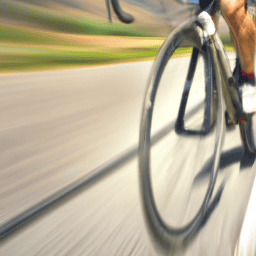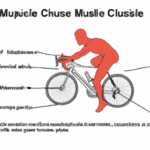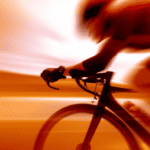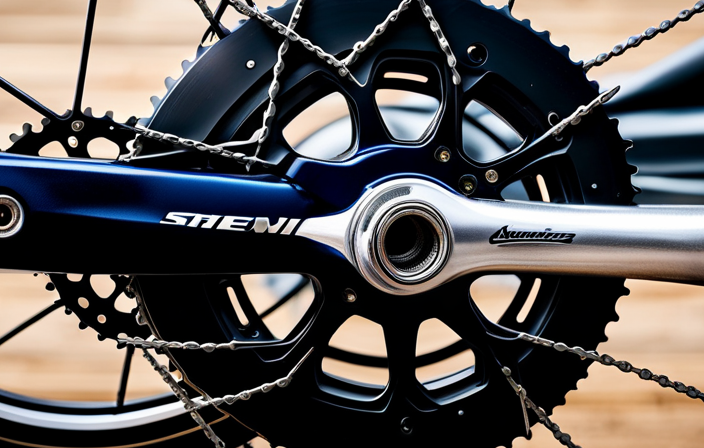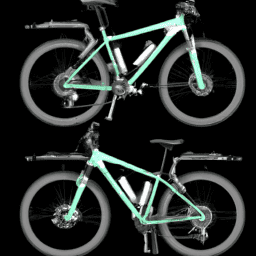Jumping on your bike, with the breeze flowing in your hair, you begin to pedal. As you gain momentum, you can sense the strength in your legs, but have you ever pondered the maximum speed attainable on a bicycle?
Factors such as terrain, wind, and your own physical abilities all come into play when it comes to cycling speed.
Cycling is not only a fun way to get around, but it’s also a great form of exercise that can improve your cardiovascular health and build muscle.
Understanding how to pedal efficiently and effectively can make a huge difference in your cycling speed.
In this article, we will explore the factors that affect your cycling speed, how to increase your pedal speed, and how to track your progress to reach your personal cycling goals.
So grab your helmet and let’s get started!
Key Takeaways
- Pedal cadence impacts speed and endurance – optimal cadence is 80-100 revolutions per minute.
- Building leg muscles through cycling-specific strength training exercises increases power.
- High pedal cadence increases efficiency, reduces injury risk, and improves endurance.
- Improving overall fitness through cardio and strength training boosts cycling performance.
Factors That Affect Your Cycling Speed
If you want to increase your cycling speed, it’s important to consider several factors that can affect your performance. One of the most critical factors is your muscle strength, which directly influences how fast you can pedal your bike. The more power your muscles can generate, the faster you can go.
It’s essential to build your leg muscles by doing cycling-specific strength training exercises like squats, lunges, and calf raises. Another crucial factor that affects your cycling speed is wind resistance. The faster you go, the more wind resistance you’ll encounter.
So, reducing your body’s frontal area by adopting an aerodynamic position can significantly improve your speed. This means lowering your torso, tucking in your elbows, and bending your arms and legs to reduce the surface area exposed to the wind. Reducing wind resistance is incredibly important when cycling at higher speeds, as it can make a significant difference in your overall performance.
Understanding these factors can help you improve your cycling speed and achieve your performance goals.
Understanding Your Pedal Cadence
When it comes to cycling, understanding your pedal cadence is crucial to improving your performance. Pedal cadence refers to the number of times your pedals turn per minute, and it can have a significant impact on your speed and endurance.
Knowing your optimal pedal cadence can help you maintain a consistent power output and reduce fatigue, but how do you measure it?
In this discussion, we’ll explore what pedal cadence is, why it’s important, and how you can measure your own pedal cadence to improve your cycling performance.
What is Pedal Cadence?
You can feel the rush of speed as you increase your pedal cadence on your bicycle. Pedal cadence is the number of revolutions per minute (RPM) your pedals make while you ride. A higher cadence means your pedals are spinning faster, which can have several advantages.
Here are some techniques for improving cadence stability and the advantages of high cadence:
- Use a lower gear: This allows you to pedal faster without using too much energy.
- Focus on your form: Keep your upper body stable and relaxed, with a slight bend in your elbows.
- Practice with intervals: Alternate between high and low cadences to build up your endurance and improve your form.
Understanding pedal cadence is important because it can affect your overall performance on the bike. In the next section, we’ll explore why pedal cadence is important and how it can impact your cycling experience.
Why is Pedal Cadence Important?
Crucial to your cycling performance is maintaining an optimal pedal cadence, as it can greatly impact the efficiency and endurance of your ride. The importance of pedal cadence in cycling lies in its effect on power output, muscle fatigue, and cardiovascular strain.
Studies have shown that a steady pedal cadence between 80-100 revolutions per minute (rpm) can improve cycling efficiency and reduce the risk of injury. Maintaining a steady pedal cadence offers a range of benefits, including reducing the strain on your muscles and joints, improving your cardiovascular endurance, and allowing you to ride longer distances with less fatigue.
By optimizing your pedal cadence, you can maximize your power output and minimize the risk of injury, allowing you to achieve your cycling goals. As such, it’s essential to measure and track your pedal cadence regularly, which we’ll discuss in the subsequent section.
How to Measure Your Pedal Cadence
Measuring your pedal cadence is easy and can be done using a device called a cadence sensor, which attaches to your bike and tracks your pedal strokes per minute. Once you have the sensor installed, simply start pedaling and the device will provide you with real-time feedback on your cadence.
Here are three benefits of maintaining a high pedal cadence:
-
Increased efficiency: Studies have shown that cyclists who maintain a higher cadence are able to generate more power with less effort. This is because a higher cadence means you’re using more of your cardiovascular system and less of your muscular system to generate power.
-
Reduced risk of injury: When you pedal with a high cadence, you put less stress on your joints and muscles, reducing your risk of injury. This is because you’re distributing the workload across a larger number of muscle groups, rather than relying on a few key muscles to do all the work.
-
Better endurance: Maintaining a consistent cadence allows you to maintain a steady pace, which is essential for endurance cycling. By using less energy per pedal stroke, you can conserve your energy and keep going for longer periods of time.
To maintain a consistent cadence, focus on keeping your pedal strokes smooth and even. Avoid mashing down on the pedals or bouncing in the saddle. Instead, try to pedal in a circular motion, keeping your feet level and your cadence steady. With practice, you can easily maintain a consistent cadence throughout your ride.
Next, we’ll explore some tips for increasing your pedal speed.
Tips for Increasing Your Pedal Speed
If you want to increase your pedal speed, there are several strategies that you can employ. First, focus on improving your overall fitness level through regular cardiovascular exercise and strength training.
Second, optimize your bike setup by adjusting your saddle height, handlebar position, and gear ratios for maximum efficiency.
Third, practice proper pedal technique by maintaining a smooth and controlled cadence and engaging your core muscles.
Finally, incorporate interval training into your cycling routine to challenge your body and improve your speed and endurance.
By following these tips, you can elevate your performance and achieve your cycling goals.
Improve Your Fitness Level
To boost your fitness level, it’s key to regularly incorporate both cardio and strength training into your exercise routine, whether that means hitting the gym or taking a spin on your bicycle. Here are some tips to help improve your fitness level when cycling:
-
Invest in proper cycling gear: Wearing the right clothes, shoes, and helmet can make a big difference in your comfort and performance on the bike. Look for breathable fabrics, padded shorts, and shoes with a stiff sole to transfer power more efficiently.
-
Fuel your body with nutrition for cyclists: Eating a balanced diet that includes plenty of carbohydrates, protein, and healthy fats can help you feel energized and recover faster. Drink plenty of water before, during, and after your ride to stay hydrated.
-
Mix up your workouts: Varying the intensity and duration of your rides can help prevent boredom and challenge your body in different ways. Try incorporating interval training, hill repeats, or long endurance rides into your routine.
-
Set goals and track your progress: Whether it’s increasing your average speed, riding a certain distance, or completing a specific route, having a goal in mind can help you stay motivated. Use a fitness tracker or app to monitor your progress and see how far you’ve come.
-
Get enough rest and recovery: Rest days are just as important as training days. Make sure to give your body time to recover between workouts, and prioritize getting enough sleep and stretching.
To optimize your bike setup, consider adjusting your saddle height, handlebar position, and pedal alignment to ensure a comfortable and efficient riding position. By taking care of your body and equipment, you can improve your pedal speed and overall cycling performance.
Optimize Your Bike Setup
Make sure your bike is set up correctly for maximum comfort and efficiency, allowing you to effortlessly glide through the streets and experience the joy of cycling. Bike customization is key to achieving this.
Start by adjusting the saddle height so that your leg is almost fully extended when the pedal is at the bottom of the stroke. This will ensure that you’re using your leg muscles efficiently and avoiding injury.
Next, consider your gear ratios. A lower gear ratio allows for easier pedaling but slower speeds, while a higher gear ratio allows for faster speeds but harder pedaling. Finding the right gear ratio for your fitness level and the terrain you’ll be cycling on is important.
Experiment with different gear ratios to find the one that works best for you. With the right bike setup, you’ll be able to pedal faster and longer, getting the most out of your cycling experience.
Now, practice proper pedal technique to further improve your speed and efficiency.
Practice Proper Pedal Technique
Improve your cycling efficiency by focusing on your pedal stroke and practicing proper pedal technique. Proper Pedal Technique involves a smooth circular motion around the entire pedal stroke, utilizing all four quadrants.
Begin by pushing down through the ball of your foot, then pulling back through the bottom of your stroke, and finally lifting up through the top of your stroke. This results in a more efficient use of your leg muscles, reducing the risk of injury and increasing your pedal power.
Common mistakes in pedal technique include mashing down on the pedals with only your quads, which can cause muscle fatigue and strain, and not engaging your hamstrings and glutes. Additionally, some cyclists pedal at a high cadence but with low resistance, which can lead to inefficient pedal strokes and reduced power output.
By focusing on proper technique and utilizing all four quadrants of the pedal stroke, you can improve your cycling efficiency and overall performance.
Transitioning into the subsequent section about using interval training, incorporating proper pedal technique can be beneficial during high-intensity intervals. By maintaining a smooth circular motion and engaging all four quadrants of your pedal stroke, you can better handle the increased resistance of interval training and improve your overall cycling endurance.
Use Interval Training
Rev up your cycling game by incorporating interval training, a powerful tool to help you pedal to new heights and overcome your limits. Interval training involves alternating periods of high-intensity exercise with periods of rest or low-intensity exercise. By doing this, you can increase your endurance, speed, and power on the bike.
One of the benefits of interval training is that it can be tailored to your specific fitness level and goals. For example, if you’re looking to improve your endurance, you can do longer intervals at a moderate intensity. If you want to work on your speed and power, shorter, high-intensity intervals may be more effective.
Some of the best interval training workouts for cycling include Tabata intervals, where you work hard for 20 seconds and rest for 10 seconds, repeat for 8 rounds, or hill repeats, where you climb a hill at a high intensity and then recover on the descent.
Incorporating interval training into your cycling routine can help you achieve your goals faster and push your limits to the next level.
Ready to track your progress and see how fast you can pedal a bicycle? The next section will show you how to monitor your cycling speed and measure your progress over time.
How to Track Your Cycling Speed
To track your cycling speed, you need to first invest in a bike computer or GPS device. These gadgets not only give you accurate speed readings, but also provide essential data such as distance covered, time elapsed, and even heart rate.
When it comes to cycling, tracking your performance is crucial in achieving your goals and making progress. By keeping track of your speed, you can monitor your progress over time and set new targets for yourself.
When choosing the right bike for speed, it’s important to consider the type of terrain you’ll be riding on. A road bike is ideal for flat, smooth surfaces, while a mountain bike is better suited for rough terrain. Additionally, a lighter bike with thinner tires can also help you pedal faster.
By investing in the right equipment and tracking your speed, you can reap the benefits of cycling and improve your overall performance.
To set personal cycling goals, it’s important to understand your current level of fitness and what you want to achieve. Whether it’s cycling a certain distance or reaching a specific speed, setting achievable targets can help you stay motivated and focused.
By tracking your progress and consistently challenging yourself, you can push beyond your limits and achieve your cycling goals.
Setting Personal Cycling Goals
When it comes to achieving your cycling goals, understanding your current level of fitness and setting achievable targets will help you stay motivated and focused – allowing you to push beyond your limits and reach new heights. Cycling goal setting is an important process that involves assessing your current fitness level and creating a roadmap to help you achieve your desired outcomes. To do this, you need to identify your strengths and weaknesses, set measurable targets, and monitor your progress regularly.
One effective way to track your progress is by using a cycling log, which allows you to record your cycling data such as distance, speed, and time. By tracking your progress over time, you can identify areas where you need to improve and set new goals that are more challenging. To help you get started, here is a simple table that you can use to set your cycling goals and monitor your progress:
| Goal | Target | Date | Progress | Achieved |
|---|---|---|---|---|
| Distance | 30 miles | 30/06/2022 | 20 miles | No |
| Speed | 15 mph | 30/06/2022 | 12 mph | No |
| Elevation gain | 1000 ft | 30/06/2022 | 800 ft | No |
| Time | 2 hours | 30/06/2022 | 1 hour 30 min | No |
| Frequency | 3 times a week | 30/06/2022 | 2 times a week | No |
Remember, the key to achieving your cycling goals is to set realistic targets, track your progress, and stay motivated. By following these steps, you can take your cycling performance to the next level and achieve your desired outcomes.
Frequently Asked Questions
What is the maximum speed that a professional cyclist can reach on a bicycle?
Professional cycling speeds depend on various factors such as training techniques and nutrition. The maximum speed a professional cyclist can reach on a bicycle is influenced by their physical abilities, the terrain they ride on, and the equipment they use.
How does the weight of the cyclist and the bike affect cycling speed?
The weight of the cyclist and the bike can significantly affect cycling speed. Wind resistance has the most impact, with a 10% increase in weight resulting in a 7.5% decrease in speed. Proper tire pressure can improve performance.
What is the difference between cycling on a flat road and cycling uphill?
Cycling uphill requires different pedaling techniques and utilizes more muscle groups than cycling on a flat road. The incline increases the resistance, requiring greater force to maintain speed. This results in a slower pace and increased exertion.
How do different types of road surfaces affect cycling speed?
Different road surfaces affect cycling efficiency and wind resistance, impacting speed. Gravel and sand slow you down, concrete and asphalt are faster. Aim for smooth, hard surfaces to optimize performance.
Can the type of bicycle gears affect cycling speed?
Efficiency comparison shows that multiple gears bikes have an advantage in varying terrains. Wind resistance plays a significant role in cycling speed, and lower gears are more efficient when facing headwinds.
Conclusion
Congratulations on reaching the end of this article! By now, you’ve got a better understanding of how fast you can pedal a bicycle and the factors that affect your cycling speed. Remember to keep track of your pedal cadence and use the tips provided to increase your pedal speed.
Tracking your cycling speed is essential to setting and achieving personal goals. Whether you’re a competitive cyclist or just looking to improve your overall performance, knowing your average speed can help you track your progress and measure your success.
So, get on your bike, set your sights high, and pedal like there’s no tomorrow! As the saying goes, "the sky’s the limit,"and with dedication and hard work, you can achieve anything you set your mind to.
